Anthony van Dyck
| Anthony van Dyck | |
|---|---|
 Self-Portrait With a Sunflower (after 1633) | |
| Born | Antoon van Dyck 22 March 1599 Antwerp, Spanish Netherlands (modern-day Belgium) |
| Died | 9 December 1641(1641-12-09) (aged 42) London |
| Nationality | Flemish |
| Education | Hendrick van Balen, Peter Paul Rubens |
| Known for | Painting |
| Movement | Baroque |
Sir Anthony van Dyck (Dutch pronunciation: [vɑn ˈdɛi̯k], many variant spellings;[1] 22 March 1599 – 9 December 1641) was a Flemish Baroque artist who became the leading court painter in England after success in the Southern Netherlands and Italy.
The seventh child of Frans van Dyck, a wealthy Antwerp silk merchant, Anthony was precocious as a youth and painted from an early age. In his late teens he was already enjoying success as an independent painter, becoming a master in the Antwerp guild in 1618. By this time he was working in the studio of the leading northern painter of the day, Peter Paul Rubens, who became a major influence on his work. Van Dyck worked in London for some months in 1621, then returned to Flanders for a brief time, before travelling to Italy, where he stayed until 1627, mostly based in Genoa. In the late 1620s he completed his greatly admired Iconography series of portrait etchings, mostly of other artists. He spent five years after his return from Italy in Flanders, and from 1630 was court painter for the archduchess Isabella, Habsburg Governor of Flanders. In 1632 he returned to London to be the main court painter, at the request of Charles I of England.
With the exception of Holbein, van Dyck and his contemporary Diego Velázquez were the first painters of pre-eminent talent to work mainly as court portraitists, revolutionising the genre. He is best known for his portraits of European aristocracy, most notably Charles I and his family and associates; Van Dyck became the dominant influence on English portrait-painting for the next 150 years. He also painted mythological and biblical subjects, including altarpieces, displayed outstanding facility as a draughtsman, and was an important innovator in watercolour and etching. His superb brushwork, apparently rather quickly painted, can usually be distinguished from the large areas painted by his many assistants. His portrait style changed considerably between the different countries he worked in, culminating in the relaxed elegance of his last English period. His influence extends into the modern period; the Van Dyke beard is named after him. During his lifetime, Charles I granted him a knighthood, and he was buried in St Paul's Cathedral, an indication of his standing at the time of his death.
Contents
1 Life and work
1.1 Education
1.2 Italy
1.3 London
2 Portraits and other works
3 Printmaking
4 Studio
5 Legacy
6 Collections
7 Gallery
8 Notes
9 References
10 External links
Life and work

Self-portrait, 1613–14
Education
Antoon van Dyck (his Flemish name) was born to prosperous parents in Antwerp. His father was Frans van Dyck, a silk merchant, and his mother was Maria, daughter of Dirk Cupers and Catharina Conincx.[2] He was baptised on 23 March 1599 (as Anthonio).[3] His talent was evident very early, and he was studying painting with Hendrick van Balen by 1609, and became an independent painter around 1615, setting up a workshop with his even younger friend Jan Brueghel the Younger.[4] By the age of fifteen he was already a highly accomplished artist, as his Self-portrait, 1613–14, shows.[5] He was admitted to the Antwerp painters' Guild of Saint Luke as a free master by February 1618.[6] Within a few years he was to be the chief assistant to the dominant master of Antwerp, and the whole of Northern Europe, Peter Paul Rubens, who made much use of sub-contracted artists as well as his own large workshop. His influence on the young artist was immense; Rubens referred to the nineteen-year-old van Dyck as "the best of my pupils".[7]
The origins and exact nature of their relationship are unclear; it has been speculated that van Dyck was a pupil of Rubens from about 1613, as even his early work shows little trace of van Balen's style, but there is no clear evidence for this.[8] At the same time the dominance of Rubens in the relatively small and declining city of Antwerp probably explains why, despite his periodic returns to the city, van Dyck spent most of his career abroad.[8] In 1620, in Rubens's contract for the major commission for the ceiling of the Carolus Borromeuskerk, the Jesuit church at Antwerp (lost to fire in 1718), van Dyck is specified as one of the "discipelen" who was to execute the paintings to Rubens' designs.[9] Unlike van Dyck, Rubens worked for most of the courts of Europe, but avoided exclusive attachment to any of them.
Italy

Genoan hauteur from the Lomellini family, 1623
In 1620, at the instigation of George Villiers, Marquess of Buckingham, van Dyck went to England for the first time where he worked for King James I of England, receiving £100.[8] It was in London in the collection of the Earl of Arundel that he first saw the work of Titian, whose use of colour and subtle modeling of form would prove transformational, offering a new stylistic language that would enrich the compositional lessons learned from Rubens.[10]
After about four months, he returned to Flanders, but moved on in late 1621 to Italy, where he remained for six years, studying the Italian masters and beginning his career as a successful portraitist. He was already presenting himself as a figure of consequence, annoying the rather bohemian Northern artist's colony in Rome, says Giovan Pietro Bellori, by appearing with "the pomp of Zeuxis ... his behaviour was that of a nobleman rather than an ordinary person, and he shone in rich garments; since he was accustomed in the circle of Rubens to noblemen, and being naturally of elevated mind, and anxious to make himself distinguished, he therefore wore—as well as silks—a hat with feathers and brooches, gold chains across his chest, and was accompanied by servants."[11]

Anthony van Dyck, by Peter Paul Rubens (1627–28)
He was mostly based in Genoa, although he also travelled extensively to other cities, and stayed for some time in Palermo in Sicily. For the Genoese aristocracy, then in a final flush of prosperity, he developed a full-length portrait style, drawing on Veronese and Titian as well as Rubens' style from his own period in Genoa, where extremely tall but graceful figures look down on the viewer with great hauteur. In 1627, he went back to Antwerp where he remained for five years, painting more affable portraits which still made his Flemish patrons look as stylish as possible. A life-size group portrait of twenty-four City Councillors of Brussels he painted for the council-chamber was destroyed in 1695.[12] He was evidently very charming to his patrons, and, like Rubens, well able to mix in aristocratic and court circles, which added to his ability to obtain commissions. By 1630, he was described as the court painter of the Habsburg Governor of Flanders, the Archduchess Isabella. In this period he also produced many religious works, including large altarpieces, and began his printmaking (see below).
London
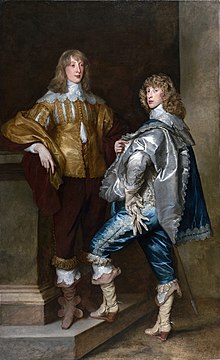
The more intimate, but still elegant style he developed in England, c. 1638
King Charles I was the most passionate collector of art among the Stuart kings, and saw painting as a way of promoting his elevated view of the monarchy. In 1628, he bought the fabulous collection that the Duke of Mantua was forced to sell, and he had been trying since his accession in 1625 to bring leading foreign painters to England. In 1626, he was able to persuade Orazio Gentileschi to settle in England, later to be joined by his daughter Artemisia and some of his sons. Rubens was an especial target, who eventually in 1630 came on a diplomatic mission, which included painting, and he later sent Charles more paintings from Antwerp. Rubens was very well-treated during his nine-month visit, during which he was knighted. Charles's court portraitist, Daniel Mytens, was a somewhat pedestrian Dutchman. Charles was very short, less than 5 feet (1.5 m) tall, and presented challenges to a portrait artist.
Van Dyck had remained in touch with the English court and had helped King Charles's agents in their search for pictures. He had also sent back some of his own works, including a portrait (1623) of himself with Endymion Porter, one of Charles's agents, a mythological work, Rinaldo and Armida (1629, now in the Baltimore Museum of Art), and a religious picture for the Queen. He had also painted Charles's sister, Queen Elizabeth of Bohemia, at The Hague in 1632. In April of that year, van Dyck returned to London and was taken under the wing of the court immediately, being knighted in July and at the same time receiving a pension of £200 a year, in the grant of which he was described as principalle Paynter in ordinary to their majesties. He was well paid for his paintings in addition to this, at least in theory, as King Charles did not actually pay over his pension for five years, and reduced the price of many paintings. He was provided with a house on the River Thames at Blackfriars, then just outside the City, thus avoiding the monopoly of the Worshipful Company of Painter-Stainers. A suite of rooms in Eltham Palace, no longer used by the royal family, was also put at his disposal as a country retreat. His Blackfriars studio was frequently visited by the King and Queen (later a special causeway was built to ease their access), who hardly sat for another painter while van Dyck lived.[8][12]

Charles I at the Hunt, c. 1635, Louvre
He was an immediate success in England, rapidly painting a large number of portraits of the King and Queen Henrietta Maria, as well as their children. Many portraits were done in several versions, to be sent as diplomatic gifts or given to supporters of the increasingly embattled king. Altogether van Dyck has been estimated to have painted forty portraits of King Charles himself, as well as about thirty of the Queen, nine of the Earl of Strafford, and multiple ones of other courtiers.[13] He painted many of the court, and also himself and his mistress, Margaret Lemon.
In England he developed a version of his style which combined a relaxed elegance and ease with an understated authority in his subjects which was to dominate English portrait-painting to the end of the 18th century. Many of these portraits have a lush landscape background. His portraits of Charles on horseback updated the grandeur of Titian's Emperor Charles V, but even more effective and original is his portrait of Charles dismounted in the Louvre: "Charles is given a totally natural look of instinctive sovereignty, in a deliberately informal setting where he strolls so negligently that he seems at first glance nature's gentleman rather than England's King".[14] Although his portraits have created the classic idea of "Cavalier" style and dress, in fact a majority of his most important patrons in the nobility, such as Lord Wharton and the Earls of Bedford, Northumberland and Pembroke, took the Parliamentarian side in the English Civil War that broke out soon after his death.[12]

Christ carrying the Cross
The King in Council by letters patent granted van Dyck denizenship in 1638, and he married Mary, the daughter of Patrick Ruthven, who, although the title was forfeited, styled himself Lord Ruthven.[15] She was a Lady-in-waiting to the Queen, in 1639-40; this may have been instigated by the King in an attempt to keep him in England.[8] He had spent most of 1634 in Antwerp, returning the following year, and in 1640–41, as the Civil War loomed, spent several months in Flanders and France. In 1640 he accompanied prince John Casimir of Poland after he was freed from French imprisonment.[16]
A letter dated 13 August 1641, from Lady Roxburghe in England to a correspondent in The Hague, reported that van Dyck was recuperating from a long illness.[17] In November van Dyck's condition worsened, and he returned to England from Paris, where he had gone to paint Cardinal Richelieu.[17] He died in London on 9 December 1641.
Portraits and other works

Samson and Delilah, c. 1630, a strenuous history painting in the manner of Rubens; the use of saturated colours reveals van Dyck's study of Titian
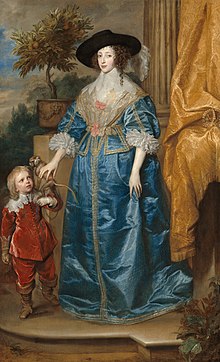
Henrietta Maria and the dwarf, Sir Jeffrey Hudson, 1633
In the 17th century, demand for portraits was stronger than for other types of work. Van Dyck tried to persuade Charles to commission him to do a large-scale series of works on the history of the Order of the Garter for the Banqueting House, Whitehall, for which Rubens had earlier done the huge ceiling paintings (sending them from Antwerp).
A sketch for one wall remains, but by 1638 Charles was too short of money to proceed.[8] This was a problem Velázquez did not have, but equally van Dyck's daily life was not encumbered by trivial court duties as Velázquez's was. In his visits to Paris in his last years van Dyck tried to obtain the commission to paint the Grande Gallerie of the Louvre without success.[18]
A list of history paintings produced by van Dyck in England survives, compiled by van Dyck's biographer Bellori, based on information from Sir Kenelm Digby. None of these works appear to remain, except the Eros and Psyche done for the King (below).[8] But many other works, rather more religious than mythological, do survive, and though they are very fine, they do not reach the heights of Velázquez's history paintings. Earlier ones remain very much within the style of Rubens, although some of his Sicilian works are individualistic.
Van Dyck's portraits certainly flattered more than Velázquez's; when Sophia, later Electoress of Hanover, first met Queen Henrietta Maria, in exile in Holland in 1641, she wrote: "Van Dyck's handsome portraits had given me so fine an idea of the beauty of all English ladies, that I was surprised to find that the Queen, who looked so fine in painting, was a small woman raised up on her chair, with long skinny arms and teeth like defence works projecting from her mouth..."[8]

The Cheeke Sisters, a late double portrait
Some critics have blamed van Dyck for diverting a nascent, tougher English portrait tradition—of painters such as William Dobson, Robert Walker and Isaac Fuller—into what certainly became elegant blandness in the hands of many of van Dyck's successors, like Lely or Kneller.[8] The conventional view has always been more favourable: "When Van Dyck came hither he brought Face-Painting to us; ever since which time ... England has excel'd all the World in that great Branch of the Art’ (Jonathan Richardson: An Essay on the Theory of Painting, 1715, 41). Thomas Gainsborough is reported to have said on his deathbed "We are all going to heaven, and Van Dyck is of the Company."[12]
A fairly small number of landscape pen and wash drawings or watercolours made in England played an important part in introducing the Flemish watercolour landscape tradition to England. Some are studies, which reappear in the background of paintings, but many are signed and dated and were probably regarded as finished works to be given as presents. Several of the most detailed are of Rye, a port for ships to the Continent, suggesting that van Dyck did them casually whilst waiting for wind or tide to improve.[19]
Printmaking
Probably during his period in Antwerp after his return from Italy, van Dyck began his Iconography, eventually a very large series of prints with half-length portraits of eminent contemporaries. Van Dyck produced drawings, and for eighteen of the portraits he himself etched with great brilliance the heads and the main outlines of the figure, for an engraver to work up: "Portrait etching had scarcely had an existence before his time, and in his work it suddenly appears at the highest point ever reached in the art".[20]
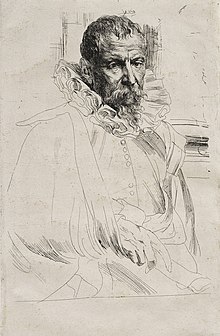
Pieter Brueghel the Younger from the Iconography; etching by van Dyck
However, for most of the series he left the whole printmaking work to specialists, who mostly engraved everything after his drawings. His own etched plates appear not to have been published commercially until after his death, and early states are very rare.[21] Most of his plates were printed after only his work had been done; some exist in further states after engraving had been added, sometimes obscuring his etching. He continued to add to the series until at least his departure for England, and presumably added Inigo Jones whilst in London.
The series was a great success, but was his only venture into printmaking; portraiture probably paid better, and he was constantly in demand. At his death there were eighty plates by others, of which fifty-two were of artists, as well as his own eighteen. The plates were bought by a publisher; with the plates reworked periodically as they wore out they continued to be printed for centuries, and the series added to, so that it reached over two hundred portraits by the late 18th century. In 1851, the plates were bought by the Calcographie du Louvre.[21]
The Iconography was highly influential as a commercial model for reproductive printmaking; now forgotten series of portrait prints were enormously popular until the advent of photography: "the importance of this series was enormous, and it provided a repertory of images that were plundered by portrait painters throughout Europe over the next couple of centuries".[12] Van Dyck's brilliant etching style, which depended on open lines and dots, was in marked contrast to that of the other great portraitist in prints of the period, Rembrandt, and had little influence until the 19th century, when it had a great influence on artists such as Whistler in the last major phase of portrait etching.[20]Hyatt Mayor wrote:
.mw-parser-output .templatequote{overflow:hidden;margin:1em 0;padding:0 40px}.mw-parser-output .templatequote .templatequotecite{line-height:1.5em;text-align:left;padding-left:1.6em;margin-top:0}
Etchers have studied Van Dyck ever since, for they can hope to approximate his brilliant directness, whereas nobody can hope to approach the complexity of Rembrandt's portraits.[22]
Studio

Van Dyck's success led him to maintain a large workshop in London, which became "virtually a production line for portraits". According to a visitor he usually only made a drawing on paper, which was then enlarged onto canvas by an assistant; he then painted the head himself. The costume in which the client wished to be painted was left at the studio and often with the unfinished canvas sent out to artists specialised in rendering such clothing.[12] In his last years these studio collaborations accounted for some decline in the quality of work.[23]
In addition many copies untouched by him, or virtually so, were produced by the workshop, as well as by professional copyists and later painters; the number of paintings ascribed to him had by the 19th century become huge, as with Rembrandt, Titian and others. However, most of his assistants and copyists could not approach the refinement of his manner, so compared to many masters consensus among art historians on attributions to him is usually relatively easy to reach, and museum labelling is now mostly updated (country house attributions may be more dubious in some cases).
The relatively few names of his assistants that are known are Dutch or Flemish; he probably preferred to use trained Flemings, as no equivalent English training existed in this period.[8]Adriaen Hanneman (1604–71) returned to his native Hague in 1638 to become the leading portraitist there.[24] Van Dyck's enormous influence on English art does not come from a tradition handed down through his pupils; in fact it is not possible to document a connection to his studio for any English painter of any significance.[8]

Charles I in Three Positions, a triple portrait of Charles I, was sent to Rome for Bernini to model a bust on
Legacy
Much later, the styles worn by his models provided the names of the Van Dyke beard for the sharply pointed and trimmed goatees popular for men in his day, and the van Dyke collar, "a wide collar across the shoulders edged copiously with lace".[25] During the reign of George III, a generic "Cavalier" fancy-dress costume called a Van Dyke was popular; Gainsborough's The Blue Boy is wearing such a Van Dyke outfit. In 1774 Derby porcelain advertised a figure, after a portrait by Johann Zoffany, of "the King in a Vandyck dress".[26]
A confusing number of different pigments used in painting have been called "Vandyke brown" (mostly in English-language sources). Some predate van Dyck, and it is not clear that he used any of them.[27]Van Dyke brown is an early photographic printing process using the same colour.
When van Dyck was knighted in 1632, he anglicized his name to Vandyke.[28]
Collections
The British Royal Collection, which still contains many of his paintings, has a total of twenty-six paintings.[29] The National Gallery, London (fourteen works), The Museo del Prado (Spain) (twenty-five works), The Louvre in Paris (eighteen works), The Alte Pinakothek in Munich, the National Gallery of Art in Washington DC and the Frick Collection have examples of his portrait style. Wilton House still holds the works he did for one of his main patrons, the Earl of Pembroke, including his largest work, a huge family group portrait with ten main figures.
Tate Britain held the exhibition Van Dyck & Britain in 2009.[30] In 2016 the Frick Collection in New York had an exhibition "Van Dyck: The Anatomy of Portraiture", the first major survey of the artist's work in the United States in over two decades.[31]
Gallery

Christ Crowned with Thorns (c. 1620) in the Prado

Elena Grimaldi, Genoa, 1623
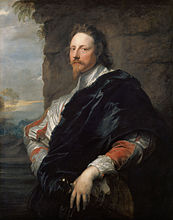
Nicholas Lanier, 1628

The Vision of the Blessed Hermann Joseph c. 1629–30

Rest on the Flight into Egypt, ca. 1630, Alte Pinakothek, Munich

Marie-Louise de Tassis, Antwerp, 1630
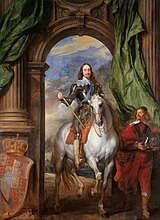
Charles I with M. de St Antoine, 1633

Katherine, Countess of Chesterfield, and Lucy, Countess of Huntingdon, c. 1636–40, oil on canvas, The Detroit Institute of Arts

Equestrian Portrait of Charles I, c. 1637–38

Cupid and Psyche, 1638

Portrait of Mary Hill, Lady Killigrew, 1638

Bewening van Christus, Anthony van Dyck, 1635, Royal Museum of Fine Arts Antwerp
Notes
^ ULAN entry. Originally "van Dijck", with the "IJ" digraph, in Dutch. Anthony is the English for the Dutch Anthonis or Antoon, though Anthonie, Antonio or Anthonio was also used; in French he is often Antoine, in Italian Anthonio or Antonio. In English a capitalised "Van" in Van Dyck was more usual until recent decades (used by Waterhouse for example), and "Dyke" was often used during his lifetime and later (and is usual for the beard style).
^ Cust, Lionel Henry. "Van Dyck Anthony". Retrieved 28 April 2018 – via Wikisource..mw-parser-output cite.citation{font-style:inherit}.mw-parser-output q{quotes:"""""""'""'"}.mw-parser-output code.cs1-code{color:inherit;background:inherit;border:inherit;padding:inherit}.mw-parser-output .cs1-lock-free a{background:url("//upload.wikimedia.org/wikipedia/commons/thumb/6/65/Lock-green.svg/9px-Lock-green.svg.png")no-repeat;background-position:right .1em center}.mw-parser-output .cs1-lock-limited a,.mw-parser-output .cs1-lock-registration a{background:url("//upload.wikimedia.org/wikipedia/commons/thumb/d/d6/Lock-gray-alt-2.svg/9px-Lock-gray-alt-2.svg.png")no-repeat;background-position:right .1em center}.mw-parser-output .cs1-lock-subscription a{background:url("//upload.wikimedia.org/wikipedia/commons/thumb/a/aa/Lock-red-alt-2.svg/9px-Lock-red-alt-2.svg.png")no-repeat;background-position:right .1em center}.mw-parser-output .cs1-subscription,.mw-parser-output .cs1-registration{color:#555}.mw-parser-output .cs1-subscription span,.mw-parser-output .cs1-registration span{border-bottom:1px dotted;cursor:help}.mw-parser-output .cs1-hidden-error{display:none;font-size:100%}.mw-parser-output .cs1-visible-error{font-size:100%}.mw-parser-output .cs1-subscription,.mw-parser-output .cs1-registration,.mw-parser-output .cs1-format{font-size:95%}.mw-parser-output .cs1-kern-left,.mw-parser-output .cs1-kern-wl-left{padding-left:0.2em}.mw-parser-output .cs1-kern-right,.mw-parser-output .cs1-kern-wl-right{padding-right:0.2em}
^ Antwerp, S.A.A., Parochieregisters, Doopakten, 30/03/1592 - 26/06/1606, fol. 147, 23-03-1599 Anthonio Van Dijck, retrieved by the Jordaens Van Dyck Panel Paintings Project (www.jordaensvandyck.org) on 06/04/2017.
^ Brown, p. 15.
^ Vlieghe, Hans. Flemish Art and Architecture, 1585–1700, Yale University Press, 2004, p. 124.
ISBN 0-300-10469-3
^ Martin, Gregory. The Flemish School, 1600-1900, National Gallery Catalogues, p. 26, 1970, National Gallery, London,
ISBN 0-901791-02-4
^ Brown, p. 17.
^ abcdefghijk Ellis Waterhouse, Painting in Britain, 1530-1790, 4th Edn, 1978, pp. 70-77, Penguin Books (now Yale History of Art series)
^ Martin, op and page cit.
^ Brown, page 19.
^ Levey, Michael, Painting at Court, Weidenfeld & Nicolson, London, 1971, pp. 124-5
^ abcdef Cust 1899.
^ Gaunt, William, English Court Painting
^ Levey p. 128
^ Cokayne, G. E., et al, The Complete Peerage, vol.iv, London, 1916, p. 385n
^ "Portret królewicza". Treasures... (in Polish). Archived from the original on 27 June 2009. Retrieved 29 August 2008.
^ ab Michael Jaffé. "Dyck, Anthony van". Grove Art Online. Oxford Art Online. Oxford University Press. Web.
^ Levey, op cit p. 136
^ Royalton-Kisch, Martin. The Light of Nature, Landscape Drawings and Watercolours by Van Dyck and his Contemporaries, British Museum Press, 1999,
ISBN 0-7141-2621-7
^ ab Arthur M. Hind, A History of Engraving and Etching, p. 165, Houghton Mifflin Co. 1923 (in USA), reprinted Dover Publications, 1963
ISBN 0-486-20954-7
^ ab Becker, D. P., in KL Spangeberg (ed), Six Centuries of Master Prints, Cincinnati Art Museum, 1993, no. 72,
ISBN 0-931537-15-0
^ Mayor, Alpheus Hyatt. Prints and People, Metropolitan Museum of Art. Princeton, 1971, no. 433-35,
ISBN 0-691-00326-2
^ Brown, pp. 84-6.
^ Rudi Ekkart and Quentin Buvelot (eds), Dutch Portraits, The Age of Rembrandt and Frans Hals, Mauritshuis/National Gallery/Waanders Publishers, Zwolle, p. 138 QB, 2007,
ISBN 978-1-85709-362-9
^ Condra, Jill, ed. (2008). The Greenwood Encyclopedia of Clothing through World History. 2 (1 ed.). United States: Greenwood Publishing Group. p. 103. ASIN B01FJ09WHC. ISBN 978-0-313-33664-5.His style coined the names of the van Dyke beard, for the sharply pointed and trimmed goatees popular for men in the first half of the century, and the van Dyke collar, a wide collar across the shoulders edged copiously with lace.
|access-date=requires|url=(help)
^ The painting, Royal Collection; Honey, W.B., Old English Porcelain, p, 147, 1977 (3rd edn.), Faber and Faber,
ISBN 0571049028
^ "Vandyke brown", Pigment Compendium, by Nicholas Eastaugh, Valentine Walsh, Tracey Chaplin, Ruth Siddall, p. 388, 2008, Routledge,
ISBN 1136373926, 9781136373923, google books
^ Massie, Allan (2013). The Royal Stuarts: A History of the Family That Shaped Britain (paperback)|format=requires|url=(help). St. Martin's Griffin (published February 5, 2013). p. 191. ISBN 978-1250024923.Van Dyck was knighted and anglicised his name to Vandyke.
^ Royal Collection Paintings by Van Dyck
^ Karen Hearn (ed.), Van Dyck & Britain, Tate Publishing, 2009.
ISBN 978-1-85437-795-1.
^ "Past Exhibition: Van Dyck - The Frick Collection". www.frick.org.
References
- Brown, Christopher: Van Dyck 1599-1641. Royal Academy Publications, 1999.
ISBN 0-900946-66-0
 Chisholm, Hugh, ed. (1911). "Van Dyck, Sir Anthony". Encyclopædia Britannica. 27 (11th ed.). Cambridge University Press.
Chisholm, Hugh, ed. (1911). "Van Dyck, Sir Anthony". Encyclopædia Britannica. 27 (11th ed.). Cambridge University Press.
 Cust, Lionel Henry (1899). "Van Dyck, Anthony". In Lee, Sidney. Dictionary of National Biography. 58. London: Smith, Elder & Co.
Cust, Lionel Henry (1899). "Van Dyck, Anthony". In Lee, Sidney. Dictionary of National Biography. 58. London: Smith, Elder & Co.
 Williamson, George Charles (1909). "Antoon Van Dyck". In Herbermann, Charles. Catholic Encyclopedia. 5. New York: Robert Appleton Company.
Williamson, George Charles (1909). "Antoon Van Dyck". In Herbermann, Charles. Catholic Encyclopedia. 5. New York: Robert Appleton Company.
Wood, Jeremy. "Dyck, Sir Anthony Van (1599–1641)". Oxford Dictionary of National Biography (online ed.). Oxford University Press. doi:10.1093/ref:odnb/28081.
(Subscription or UK public library membership required.)
External links
| Wikimedia Commons has media related to Anthony van Dyck. |
The Oliver Millar Archive; research papers of Oliver Millar, British art historian and a leading authority on Anthony van Dyck- Van Dyck at the National Gallery of Art
583 paintings by or after Anthony van Dyck at the Art UK site- The National Gallery: Van Dyck, with short biography
- The National Portrait Gallery: Van Dyck
Peter Paul Rubens. "Sir Anthony Van Dyck". Royal Collection Trust. Inventory no. 404429.
Vermeer and The Delft School, a full text exhibition catalog from The Metropolitan Museum of Art, which has material on Anthony van Dyck- Jordaens Van Dyck Panel Paintings Project
| Court offices | ||
|---|---|---|
| Preceded by — | Principal Painter in Ordinary to the King –1641 | Succeeded by Sir Peter Lely |











